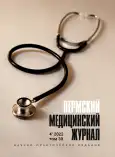Gender features of malignant neoplasms associated with human papillo-mavirus in St. Petersburg
- Authors: Lyalina L.V.1, Kholopov D.V.1, Khizha V.V.2, Kasatkin E.V.3, Topuzov Е.Е.4
-
Affiliations:
- Pasteur St. Petersburg Research Institute of Epidemiology and Microbiology
- Medical Information and Analytical Center
- Dermatovenerologic Dispensary № 8
- City Clinical Oncological Dispensary
- Issue: Vol 39, No 4 (2022)
- Pages: 144-154
- Section: Preventive and social medicine
- URL: https://bakhtiniada.ru/PMJ/article/view/110826
- DOI: https://doi.org/10.17816/pmj394144-154
- ID: 110826
Cite item
Full Text
Abstract
Objective.To study the peculiarities of morbidity and mortality from malignant neoplasms associated with the human papillomavirus among male and female population in a megalopolis. The International Agency for Research on Cancer relates cancer of the oral cavity, tonsils and oropharynx, larynx, anal canal and skin of the perianal region, vulva, vagina, cervix and penis to malignant neoplasms associated with the human papillomavirus.
Material and methods. The analysis of morbidity and mortality was carried out according to the Population Cancer Registry of St. Petersburg for the period 2011–2020. The structure of the localization of the tumor process, trends and levels of morbidity and mortality from neoplasia associated with papillomavirus infection were studied. The study included information on 13,117 cases of the disease and 7,257 deaths.
Research methods: epidemiological, clinical, statistical methods.
Results. Among all the malignant neoplasms, the proportion of HPV-associated neoplasias was 5.1 % in men and 5.8 % in women (p < 0.05). In the structure of morbidity and mortality from HPV-associated tumors, cancer of the oral cavity and larynx occupies the largest share among men, and cervical cancer among women. The incidence of oropharyngeal cancer among the male population is higher compared to the female, the incidence of anal cancer among women is 2.9 times higher and there is an upward trend with higher growth rates (p < 0.05).
Conclusions. The established gender differences of HPV-associated malignant neoplasms should be taken into account when justifying the directions for improving dispensary monitoring of patients and vaccination of papillomavirus infection.
Full Text
##article.viewOnOriginalSite##About the authors
L. V. Lyalina
Pasteur St. Petersburg Research Institute of Epidemiology and Microbiology
Author for correspondence.
Email: lyalina@pasteurorg.ru
MD, PhD, Professor, Head of Laboratory of Epidemiology of Infectious and Non-Infectious Diseases
Russian Federation, St. PetersburgD. V. Kholopov
Pasteur St. Petersburg Research Institute of Epidemiology and Microbiology
Email: lyalina@pasteurorg.ru
graduate student
Russian Federation, St. PetersburgV. V. Khizha
Medical Information and Analytical Center
Email: lyalina@pasteurorg.ru
MD, PhD, Head of Department of Medical Statistics of Tumor Diseases
Russian Federation, St. PetersburgE. V. Kasatkin
Dermatovenerologic Dispensary № 8
Email: lyalina@pasteurorg.ru
Candidate of Medical Sciences, Head Doctor
Russian Federation, St. PetersburgЕ. Е. Topuzov
City Clinical Oncological Dispensary
Email: lyalina@pasteurorg.ru
MD, PhD, Professor, Head Doctor
Russian Federation, St. PetersburgReferences
- Wild C.P., Weiderpass E., Stewart B.W., editors (2020). World Cancer Report: Cancer Research for Cancer Prevention. Lyon, France: International Agency for Research on Cancer, available at: http://www.publications.iarc.fr/586.
- Bruni L., Albero G., Serrano B. et al. ICO/IARC Information Centre on HPV and Cancer (HPV Information Centre). Human Papillomavirus and Related Diseases in the World. Summary Report. 2022.
- de Martel C., Plummer M., Vignat J. et al. Worldwide burden of cancer attributable to HPV by site, country and HPV type. Int J Cancer. 2017; 141 (4): 664–670.
- Hyuna Sung, Jacques Ferlay, Rebecca L. Siegel, et al. Global Cancer Statistics 2020: GLOBOCAN Estimates of Incidence and Mortality Worldwide for 36 Cancers in 185 Countries. CA: A Cancer Journal for Clinicians. 2021; 71 (3): 209–249.
- Gretsova O.P., Kostin A.A., Samsonov Yu.V. et al. Morbidity and mortality from malignant neoplasms associated with human papillomavirus. Research’n Practical Medicine Journal. 2017; 4 (3): 33–50 (in Russan).
- Kaprin A.D., Starinskii V.V., Shakhzadova A.O. Malignant neoplasms in Russia in 2020 (morbidity and mortality). Moscow: P. Hertsen MORI – branch of the FSBI NMRRC of the Ministry of Health of the Russian Federation 2021; 252 (in Russan).
- Arbyn M., Weiderpass E., Bruni L. et al. Estimates of incidence and mortality of cervical cancer in 2018: a worldwide analysis. Lancet Glob Health. 2020; 8 (2): 191–203.
- Vaginal cancer incidence statistics. Cancer Research UK. 2020, available at: https:// www.cancerresearchuk.org/health-professional/ cancer-statistics/statistics-by-cancer-type/vaginal-cancer/incidence#heading-One.
- Worldwide cancer data, 2020. World Cancer Research Fund International. 2020, available at: https://www.wcrf.org/dietandcancer/worldwide-cancer-data.
- Heer E., Hackl M., Et M. et al. Trends in incidence of anal cancer in Austria, 1983–2016. Wien Klin Wochenschr. 2020; 132 (15): 438–443.
- Hansen B.T., Orumaa M., Lie A.K., Brennhovd B., Nygård M. Trends in incidence, mortality and survival of penile squamous cell carcinoma in Norway 1956–2015. Int J Cancer. 2018; 142 (8): 1586–1593.
- Cancer Stat Facts: Oral Cavity and Pharynx Cancer. Surveillance, Epidemiology, and End Results Programe 18, 2010–2016. National Cancer Institute, 2018, available at: https://www. seer.cancer.gov/statfacts/html/oralcav.html.
- Perea L.M., Estrada Peres M.A., Boing A. Fernando, et al. Trend of oral and pharyngeal cancer mortality in Brazil in the period of 2002 to 2013. Rev. Saúde Pública. 2018; 52.
- Nelson V.M., Benson A.B., 3rd. Epidemiology of Anal Canal Cancer. Surg Oncol Clin N Am. 2017; 26 (1): 9–15.
- Mensah F.A., Mehta M.R., Lewis J.S., Jr., et al. The human papillomavirus vaccine: current perspective and future role in prevention and treatment of anal Intraepithelial neoplasia and anal cancer. Oncologist. 2016; 21 (4): 453–460.
- Briko N.I., Lopukhov P.D., Kaprin A.D., et al. HPV-associated lesions in the Russian Federation: assessment of the problem. Journal of Modern Oncology. 2019; 21 (1): 45–50 (in Russan).
- Lyalina L.V. Epidemiological, social and economic evidences of vaccination against human papillomavirus infection in Saint-Petersburg. Infektsiya i immunitet = Russian Journal of Infection and Immunity. 2014; 4 (2): 181–186 (in Russan).
Supplementary files









